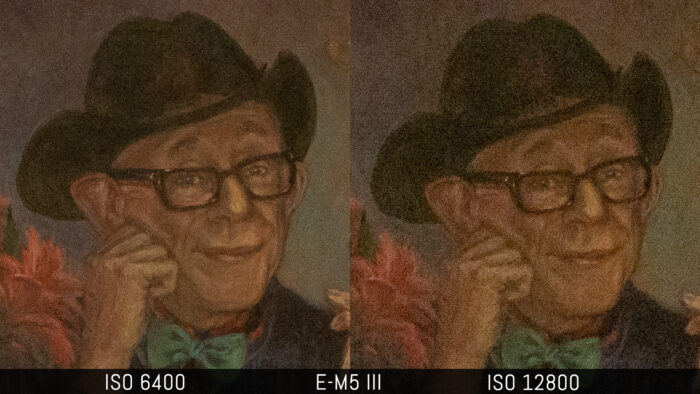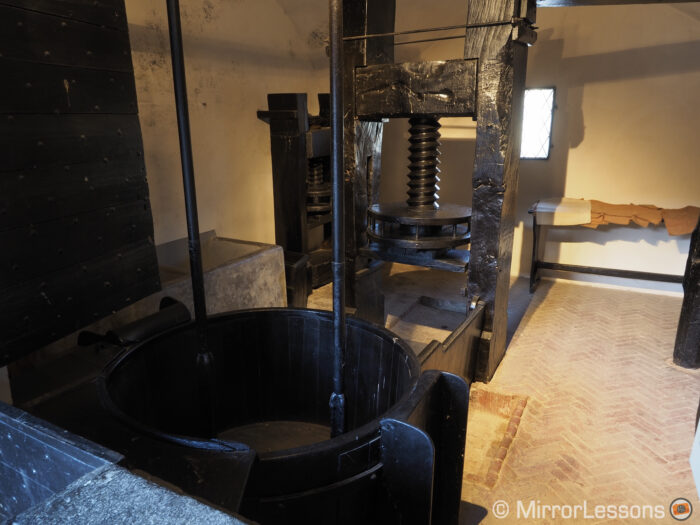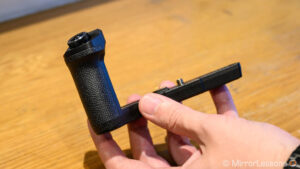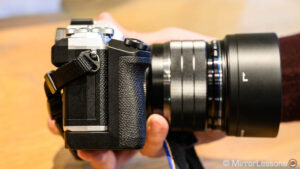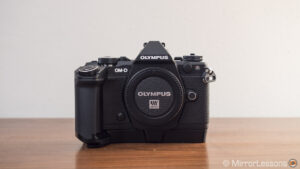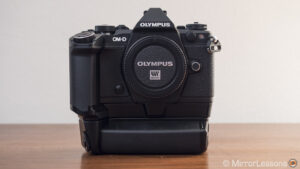The E-M5 series has a special place in our hearts because the original E-M5 was the first mirrorless model we tested when we started our blogging venture in 2013. At the time, the camera introduced very interesting technology such as five axis stabilisation while also providing advanced weather sealing for a reasonable price.
The E-M5 II came out three years later with improved stabilisation and the first high res shot mode on a mirrorless model. It was also Olympus’ first attempt at adding more serious video features.
The E-M5 III arrives 7 years after the original model was announced. This time there is nothing new that we haven’t already seen elsewhere but it does bring a series of important updates. Let’s see how the new camera and its predecessor compare.
What the E-M5 II and E-M5 III share in common:
- weather sealing (dust, moisture and cold temperatures down to -10ºC)
- live time and live composite
- high res shot mode (tripod only)
- focus bracketing and focus stacking
- scene modes and art filters
- 1/8000s shutter speed with mechanical shutter
- vari-angle LCD monitor with touch sensitivity
- 1 SD card slot (UHS-II for the E-M5 III)
- wifi
E-M5 III comparison previews:
E-M5 II vs E-M5 III – E-M5 III vs E-M1 II – E-M5 III vs E-M10 III –
E-M5 III vs EOS M6 II
Ethics statement: the following is based on our hands-on with the E-M5 III at the UK press event and our personal experience with the E-M5 II that we tested in 2015. We were not asked to write anything about these products, nor were we provided with any sort of compensation. Within the article, there are affiliate links. If you buy something after clicking the link, we will receive a small commission. To know more about our ethics, you can visit our full disclosure page. Thank you!
Note about the E-M5 III samples
As you can imagine, the ORF (RAW) files of the E-M5 III are not yet compatible with popular software such as Adobe Lightroom at the time of publishing this article. To open them, I changed the camera model name in the exif data so that the program would interpret the files as E-M1X files. It’s a trick that I’ve used quite a lot in the past and it allows me to get a good preview of how the files behave in my favourite editing software.
1. Image quality: the usual suspects
The E-M5 II features a 16.1MP sensor whereas the E-M5 III inherits the 20.4MP chip found inside the E-M1 II and E-M1X. Olympus informed me that it is an updated version, although I have yet to see what kind of benefits it may bring. With the E-M1X, Olympus tweaked the sensitivity to improve shadow recovery but as a result highlight recovery decreased. Whatever it is, don’t expect any drastic image quality change in comparison to the E-M1 series.
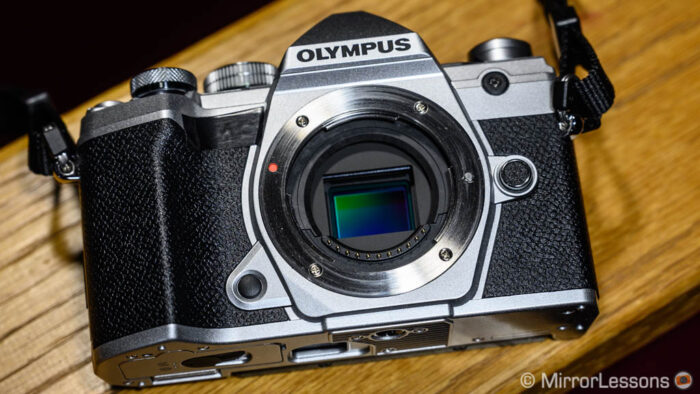
The image processor has been updated too, unsurprisingly. The TruPic VII found inside the E-M5 II is quite old now whereas the more powerful TruPic VIII allows for more processing speed and other improvements.
The sensitivity range is the same: 200 to 25600 ISO. The low setting is available and is the equivalent of ISO 100 on the mark II and ISO 64 on the mark III model. Olympus claims a 2 stop improvement concerning noise at high ISO in comparison to the E-M5 II, where 6400 ISO on the new camera should compare to 1600 on the old one.
I have yet to test them side by side to see if this is indeed the case. I have never seen a 2 stop improvement between 16MP and 20MP sensors when comparing other micro four thirds cameras, but the gap between these two models is larger so perhaps there will be a bit more to talk about.
Below you can see an example at 6400 and 12800 ISO taken with the new camera. I’ve kept noise reduction to a minimum (just enough to get rid of colour noise) and raised the exposure by 0.5Ev. The 6400 crop looks quite good whereas noise increases considerably at 12800 ISO.

The E-M5 III sensor has an updated SSWF mechanism. The Super Sonic Wave Filter causes the membrane vibrate 30,000 times per second when you turn on the camera to get rid of dust. This is the same implementation seen on the E-M1X.
Finally, both cameras can take pictures with the High Res shot mode, where 8 images taken with a half a pixel sensor shift between each shot are combined to create more resolution than what the native sensor has to offer. The E-M5 II can deliver a 40MP JPG or 64MP RAW file, whereas the E-M5 III can output 50MP and 80MP respectively.

2. Autofocus: phase difference finally!
The autofocus is one of the most important updates for the E-M5 III. To my eyes it is the most important actually.
The E-M5 II uses an outdated contrast detection system with 81 points. It’s fast in single mode and decent in continuous AF but struggles with fast subjects, low light and other scenarios. The video performance is slow.

The E-M5 III inherits the same phase detection system found on the E-M1 II and E-M1X with 121 cross-type phase detection points. This means better performance in C-AF and Tracking, especially when taking pictures of sports and birds in flight.

The camera inherits the same algorithm seen on the E-M1X where the recorded images are analysed in addition to the live view to improve accuracy. Olympus said that the algorithm has been further tweaked to prevent the autofocus from jumping to the background. Low light sensitivity has been improved as well and is the same as the E-M1X (-6Ev with f1.2 aperture). The E-M1X is the best micro four thirds camera we’ve tested when it comes to autofocus so hopefully the E-M5 III is on the same level.
In my brief time with the E-M5 III, I definitely noticed a welcome improvement in video mode, with the camera being able to follow the subject even in low light conditions, as you can see below.
Face and Eye detection is present on both cameras and once again phase detection AF improves speed and accuracy on the new camera.
There are more focus area options on the E-M5 III. In addition to All-Target, 9-Group and Single Target, you get the 5-cross and 5×5 Group modes.
3. Video: 4K update
Video is another big update for the E-M5 line-up. The mark II model can record 1080p up to 60p (52Mbps) or up to 30p with the All-Intra compression (77Mbps). While the camera provides decent quality, it never managed to reach the same level as other competitors when it comes to sharpness.
The E-M5 III can record in 4K up to 30p and 102Mbps, or Cinema 4K at 237Mbps but keep in mind that the latter is variable.
In 1080p, the new camera can record up to 120fps and the bitrate in Full HD is 202Mbps up to 30fps.
The E-M5 III features a mic input (3.5mm type) on the body like the E-M5 II. With the latter you can also get a headphone output with the optional HDL-8G landscape grip. Strangely, Olympus didn’t replicate the same feature for the new ECG-5 grip designed for the E-M5 III.
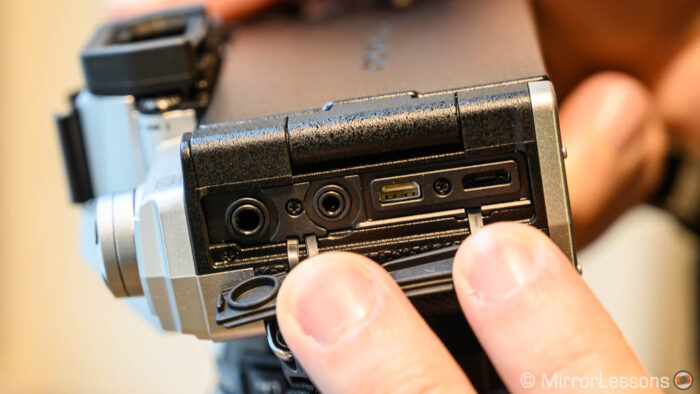
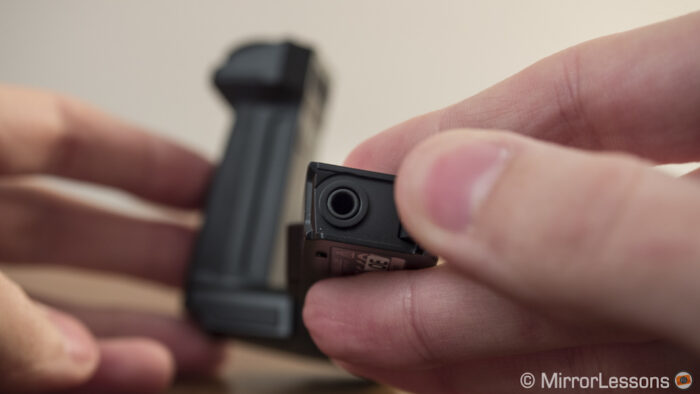
The Flat Picture mode is available on both cameras but the OM-Log400 curve has been left out on the new model.
4. Shooting speed: now with Pro Capture
The E-M5 II can shoot up to 10fps with the High mode, but focus is locked on the first frame. If you want continuous autofocus, you need to select the Low mode which decreases the speed to 5fps. The E-M5 III does the same but the Low mode is sligthly faster at 6fps.
Switch to the electronic shutter, and the new model can go up to 30fps in S-AF or 10fps in C-AF, whereas the old model is slightly faster at 11fps (S-AF). The shutter speed can be increased to 1/32000s, which is one stop faster than 1/16000s on the E-M5 II.
Also new to the E-M5 series is the Pro Capture mode. First introduced on the E-M1 II, it allows you to save images before fully depressing the shutter button. When you half press the button, the camera starts to load up to 14 frames in the buffer memory and keeps updating them in a continuous cycle until you start taking pictures. This allows you to catch fast moments such as a bird flying off a branch.

The E-M5 III receives an anti-flicker mode. Under artificial light sources, the camera will keep a constant exposure between frames. With the Flicker Scan mode, you can select the appropriate shutter speed to reduce flickering.
5. 5-axis stabilisation: a family affair
The E-M5 II has an advanced five axis stabilisation system that works up to 5Ev steps of compensation (CIPA). This rating may sound no different from many others but, in real word use, Olympus’ know-how makes all the difference. When it came out, the E-M5 II was the most advanced IBIS to date and allowed me to take pictures down to 2s hand held.
It was an impressive step forward for video too although you had to watch out for distortion and jello effects caused by the rolling shutter when moving.
Today, the performance has been outranked by other Olympus cameras such as the E-M1 II and the E-M1X, with a few Lumix models getting close.
The E-M5 III has a newly developed unit that increases the performance slightly (5.5EV, same rating as the E-M1 II). During my hands-on time with it, I managed to push it to around 1s and 2s easily enough.
Both cameras are compatible with Sync IS, which combines sensor and optical stabilisation. With the 12-100mm Pro, the E-M5 III has a rating of 6.5Ev (like the E-M1 II) so I might be able to improve my score later on when I fully test the camera.
Below, you can watch a quick stabilisation test in video mode with the new camera that looks very promising.
6. Build quality and design: from metal to plastic
Olympus has made the E-M5 III lighter by changing the body materials (as well as using a smaller battery and re-designing the sensor shift unit).
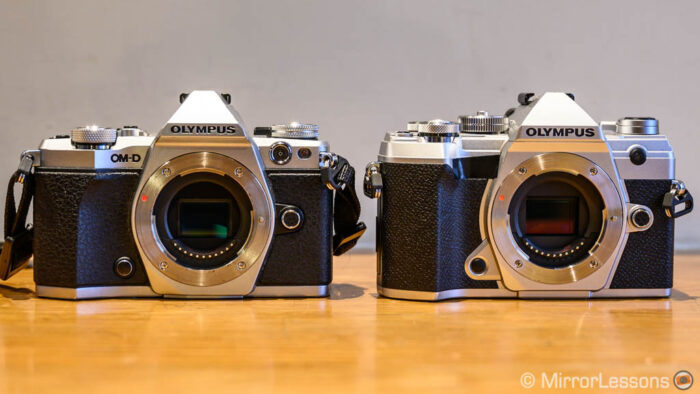
- E-M5 II: 123.7 x 85 x 44.5mm, 469g
- E-M5 III: 125.3 x 85.2 x 49.7mm, 414g
Instead of magnesium alloy, it uses polycarbonate. The camera definitely feels lighter but also more plasticky to the touch. That being said, full weather sealing is preserved just like the other model, including freeze proofing down to -10ºC.
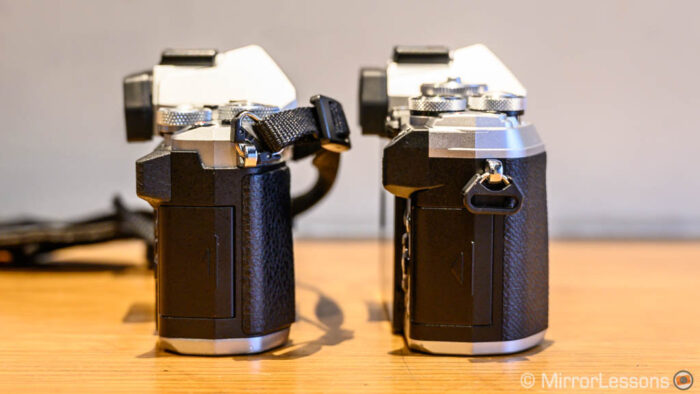
For the rest, the design of the camera is similar. On the front, the flash sync socket has disappeared. The thumb grip on the rear is a bit larger and has a new ISO button. The front grip is a bit taller to improve the handling.
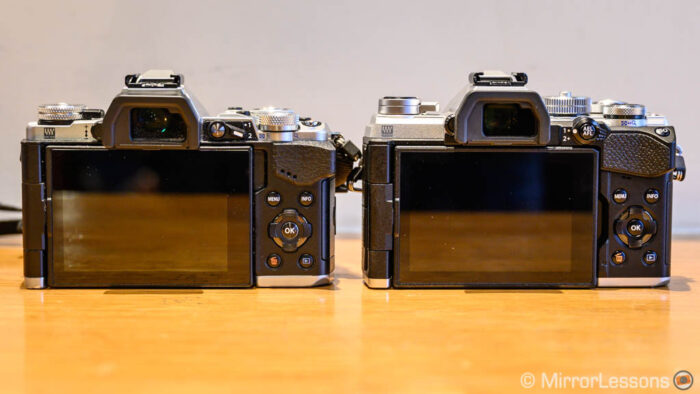
On top, the shooting mode dial has been moved to the right to make space on the left for the drive and display buttons (most certainly customisable). The main dial has a B mode to access feature such as Bulb, Live Time and Live Composite more quickly, as well as a C mode (Custom) instead of the Photo Story step.
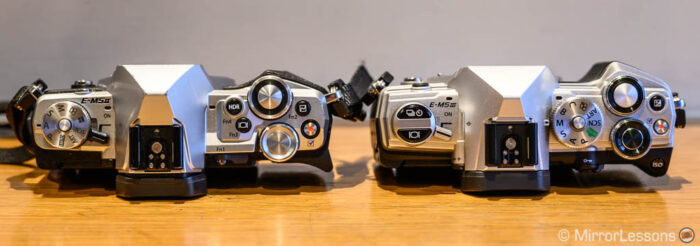
Handling can be improved with the optional ECG-5 landscape grip that includes a front dial and shutter button. Olympus told us that there won’t be a battery grip for the new camera.
The E-M5 II can use a different landscape grip (HDL-8G) that includes a headphone output. It is compatible with the HDL-6P battery grip.
7. Viewfinder: longer eyepoint
The electronic viewfinder on the E-M5 II has a resolution of 2,360k dots and a magnification of 1.48x (0.74x).
The E-M5 III uses an OLED panel instead of LCD. The resolution is the same but the magnification is smaller (0.69x). It has a longer eyepoint – 27mm instead of 21mm – which helps those who wear glasses to see the entire frame including the corners. I can confirm this directly since I wear glasses all the time and you can just about see the four extreme corners of the screen.
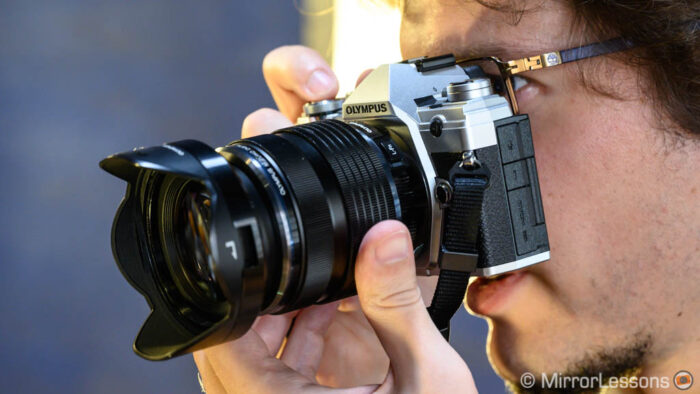
8. Battery: smaller but with USB support
The E-M5 III uses the smaller BLS-50 battery (the same as the E-M10 III) rather than the BLN-1 found inside the E-M5 II. Olympus claims that the battery life is the same (310 shots, or 750 shots with Quick Sleep mode by CIPA standards) because battery technology has improved over the years, as has the circuitry running inside the camera. This is something we’ll have to check when we perform our full comparison.
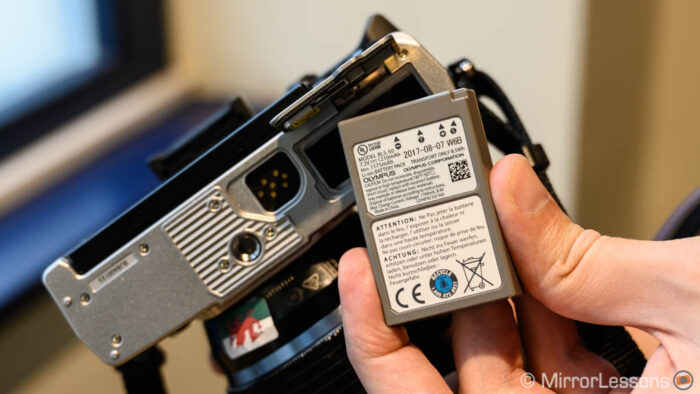
One good piece of news for sure is that the E-M5 III can be charged via the micro USB port with a laptop, power bank or any USB power source.
9. Bluetooth
Bluetooth is becoming the standard on most mirrorless cameras nowadays so it makes sense to see it advertised on the E-M5 III.
I have to test how it works on the new camera, but on the E-M1X Bluetooth doesn’t really give you that much of a benefit. It is supposed to help you pair with your smartphone faster but whenever you want to transfer images, a wifi connection is still required and doesn’t always connect automatically (at least with iOS). I hope this has been improved on the E-M5 III.
One nice thing to know is that the new camera can transfer RAW files to your mobile device in addition to JPGs.
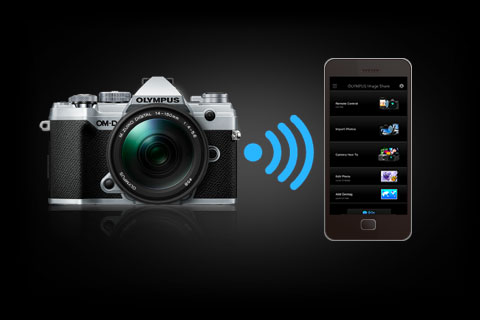
10. Price
The E-M5 II is older and can be found for less:
- $900 / £800 / €950 body only
- $1000 / £1200 / €1050 with the 14-150mm f4-5.6 II
- $1700 / £1500 / €1550 with the 12-40mm 2.8 Pro
Note that at some online stores, the price of the E-M5 II is much lower. There have also been some special offers in select countries, probably with the intent of clearing the remaining stock.
The E-M5 III starts at a higher price as expected:
- $1200 / £1100 / €1200 body only
- £1600 / €1800 with the 12-200mm f3.5-6.3
- $1800 / £1700 / €1900 with the 12-40mm 2.8 Pro
Please note that price can change over time for various reasons (depreciation, special offers, cash-backs, etc). Check the links after the conclusion to see the latest price update.
Conclusion
E-M5 III comparison previews:
E-M5 II vs E-M5 III – E-M5 III vs E-M1 II – E-M5 III vs E-M10 III –
E-M5 III vs EOS M6 II
Four years feels like a long time in a market where consumer electronics tend to be updated on a yearly or biennial basis. The E-M5 II felt outdated when pitched against its recent direct rivals but its successor has finally arrived to reset the balance.
As always, it’s too early to judge the product without a full test, but I think it’s pretty safe to say that the E-M5 III doesn’t bring anything revolutionary or exciting like its predecessors did. Rather, it brings those necessary upgrades that make the series competitive again. The most welcome addition is without a doubt phase detection autofocus, and the addition of 4K video means you can record quality footage with the best stabilisation system there is.
The new plastic build will have to be put through a long term test to see if durability can be compared to the E-M5 II. At least weather sealing is guaranteed which is a good thing.
If you’re coming from the old 16MP sensor, you’ll welcome the extra resolution, better dynamic range and high ISO performance (nothing jaw dropping but better than nothing). If you’re already accustomed to the 20MP sensor, the changes will be less noticeable.
Reminder: the links below are affiliate links. If you decided to buy something after clicking the link, we will receive a small commission.
Check price of the E-M5 II on
Amazon | Amazon UK | B&H Photo | eBay
Check price of the E-M5 III on
B&H Photo

